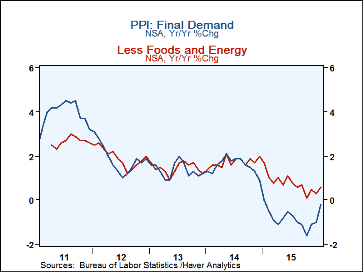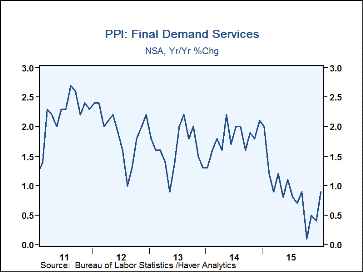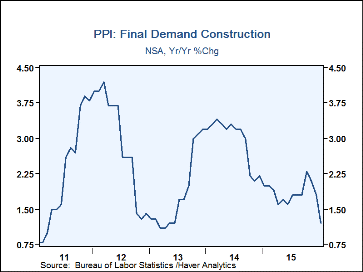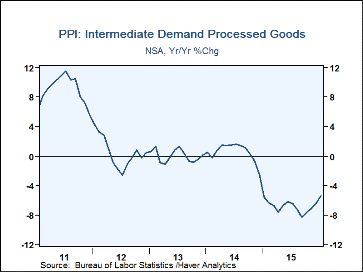 Global| Feb 17 2016
Global| Feb 17 2016U.S. Producer Prices Rise Unexpectedly in January
by:Sandy Batten
|in:Economy in Brief
Summary
The headline Final Demand Producer Price Index edged up 0.1% m/m (-0.2% y/y) in January. While this was a modest increase, it was 0.3%-pt above the Action Economics Forecast Survey expectation for a 0.2% m/m decline (this is a [...]
The headline Final Demand Producer Price Index edged up 0.1% m/m (-0.2% y/y) in January. While this was a modest increase, it was 0.3%-pt above the Action Economics Forecast Survey expectation for a 0.2% m/m decline (this is a considerable miss). Final demand producer prices excluding food and energy components also rose quite a bit more than expected in January, rising 0.4% m/m (0.6% y/y) against an expected 0.1% monthly gain. Given the volatility and difficulty interpreting changes in prices of trade services, both the financial markets and the BLS have begun to shift their view of "core" PPI inflation to final demand prices excluding food, energy, and trade services prices from the historical "core" measure, which excluded only food and energy prices. This "new" core measure rose 0.2% m/m in January, the same monthly increase as in December to stand 0.8% higher than a year earlier.
In January, a 0.5% m/m increase in services prices was mostly offset by a 0.7% m/m decline in goods prices. The fall in good prices reflected a widely expected decline in energy prices (-5.0% m/m with gasoline prices falling 8.8% m/m) and a somewhat surprising 1.0% m/m increase in food prices (led by a 17.3% m/m jump in prices of fresh and dry vegetables). Goods prices excluding food and energy prices were unchanged in January and were also unchanged from a year earlier.
Typically, changes in overall services prices have reflected swings in prices of trade services (changes in margins received by retailers and wholesalers). Indeed, these prices jumped 0.9% m/m (0.8% y/y) in January following a 0.1% m/m decline in December and a 1.3% m/m rise in November. Also boosting services prices was an outsized 6.6% m/m (NSA) jump in prices of investment services in January. This monthly increase was the largest in the six-year history of the series by a factor of two.
Final demand construction prices fell 0.4% m/m in January but were up 1.2% from a year earlier.
Prices of processed goods for intermediate demand slumped 1.2% m/m in January and were 5.4% lower than a year earlier.
The PPI data are contained in Haver's USECON database with further detail in PPI and PPIR. The expectations figures are available in the AS1REPNA database.
| Producer Price Index (SA, %) | Jan | Dec | Nov | Jan Y/Y | 2015 | 2014 | 2013 |
|---|---|---|---|---|---|---|---|
| Final Demand | 0.1 | -0.2 | 0.4 | -0.2 | -0.9 | 1.6 | 1.4 |
| Excluding Food & Energy | 0.4 | 0.2 | 0.3 | 0.6 | 0.8 | 1.7 | 1.5 |
| Excluding Food, Energy & Trade Services | 0.2 | 0.2 | 0.1 | 0.8 | 0.6 | 1.2 | -- |
| Goods | -0.7 | -0.7 | 0.1 | -2.5 | -4.3 | 1.3 | 0.8 |
| Foods | 1.0 | -1.4 | 0.3 | -3.5 | -2.6 | 3.2 | 1.7 |
| Energy | -5.0 | -3.5 | 0.5 | -11.5 | -20.6 | -0.9 | -0.8 |
| Goods Excluding Food & Energy | 0.0 | 0.1 | 0.0 | 0.0 | 0.4 | 1.5 | 1.1 |
| Services | 0.5 | 0.1 | 0.5 | 0.9 | 0.9 | 1.8 | 1.6 |
| Construction | -0.4 | 0.0 | -0.3 | 1.2 | 1.9 | 2.9 | 1.8 |
| Intermediate Demand - Processed Goods | -1.2 | -1.0 | -0.4 | -5.4 | -6.9 | 0.6 | 0.0 |
Sandy Batten
AuthorMore in Author Profile »Sandy Batten has more than 30 years of experience analyzing industrial economies and financial markets and a wide range of experience across the financial services sector, government, and academia. Before joining Haver Analytics, Sandy was a Vice President and Senior Economist at Citibank; Senior Credit Market Analyst at CDC Investment Management, Managing Director at Bear Stearns, and Executive Director at JPMorgan. In 2008, Sandy was named the most accurate US forecaster by the National Association for Business Economics. He is a member of the New York Forecasters Club, NABE, and the American Economic Association. Prior to his time in the financial services sector, Sandy was a Research Officer at the Federal Reserve Bank of St. Louis, Senior Staff Economist on the President’s Council of Economic Advisors, Deputy Assistant Secretary for Economic Policy at the US Treasury, and Economist at the International Monetary Fund. Sandy has taught economics at St. Louis University, Denison University, and Muskingun College. He has published numerous peer-reviewed articles in a wide range of academic publications. He has a B.A. in economics from the University of Richmond and a M.A. and Ph.D. in economics from The Ohio State University.










